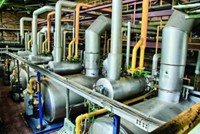Advertisement
Grab your lab coat. Let's get started
Welcome!
Welcome!
Create an account below to get 6 C&EN articles per month, receive newsletters and more - all free.
It seems this is your first time logging in online. Please enter the following information to continue.
As an ACS member you automatically get access to this site. All we need is few more details to create your reading experience.
Not you? Sign in with a different account.
Not you? Sign in with a different account.
ERROR 1
ERROR 1
ERROR 2
ERROR 2
ERROR 2
ERROR 2
ERROR 2
Password and Confirm password must match.
If you have an ACS member number, please enter it here so we can link this account to your membership. (optional)
ERROR 2
ACS values your privacy. By submitting your information, you are gaining access to C&EN and subscribing to our weekly newsletter. We use the information you provide to make your reading experience better, and we will never sell your data to third party members.
Environment
Boiler Battle
Chemical industry, lawmakers fear job losses from costly air toxics rule
by Glenn Hess
December 13, 2010
| A version of this story appeared in
Volume 88, Issue 50

The Environmental Protection Agency has decided to revise its plan for cleaning up toxic air pollution from the nation’s nearly 200,000 industrial boilers after industry groups and members of Congress warned that the original proposal would put hundreds of thousands of manufacturing jobs at risk without providing any meaningful public health or environmental benefits.
The agency contends that up to 5,000 premature deaths could be prevented each year by sharply reducing emissions of hazardous air pollutants from boilers, which are used to generate steam and power operations at chemical plants, oil refineries, paper mills, and other industrial facilities across the country.
But meeting the strict emissions limits and monitoring requirements of the rule as originally proposed in April could cost U.S. businesses tens of billions of dollars, according to industry estimates.
The agency is currently under a court order to issue a final rule under the Clean Air Act limiting emissions from industrial boilers by Jan. 16, 2011. However, EPA announced last week that it intends to rewrite the draft plan to reflect new information it has received since proposing the rule.
“After receiving additional data through the extensive public comment period, EPA is requesting more time to develop these important rules,” says Gina McCarthy, assistant administrator for EPA’s Office of Air & Radiation. “We want to ensure these rules are practical to implement and protect all Americans from dangerous pollutants such as mercury and soot, which affect kids’ development, aggravate asthma, and cause heart attacks.”
As a result, she says, EPA is asking the U.S. District Court for the District of Columbia to extend the agency’s deadline for issuing a final rule until April 2012.
“We’re encouraged that EPA is taking the time needed to develop an effective, achievable final rule,” says Calvin M. Dooley, president and chief executive officer of the American Chemistry Council (ACC), a trade association representing the nation’s largest chemical companies.
The rule setting limits on toxic emissions from boilers was first issued in 2004 by the Bush Administration. But in 2007, a three-judge panel of the U.S. Court of Appeals for the District of Columbia Circuit found that measure deficient because it failed to properly distinguish “industrial boilers” from “solid waste incinerators,” which are regulated under separate sections of the Clean Air Act.
Under the Obama Administration’s April proposal, companies would have been required to install state-of-the-art pollution controls—known as maximum achievable control technology (MACT)—on about 183,000 boilers at 92,000 facilities to reduce harmful emissions that erode air quality and pose a threat to public health. At the time, EPA said the rule would result in a reduction of 1,500 tons of toxic air pollutants per year, and compliance would cost industry $9.5 billion.
EPA said its draft plan for curbing boiler emissions would provide a series of benefits, including a reduction in asthma attacks, bronchitis, heart attacks, hospital visits, and lost workdays. The agency estimated the annual health benefits at $18 billion to $44 billion.
But as the Administration prepared to issue the final rule, trade groups representing chemical and oil companies, the forest products industry, and other businesses argued that EPA was vastly underestimating the costs and burden the so-called boiler MACT rule would impose on them.
An economic impact study by independent research firm IHS Global Insight says the proposal would have put more than 300,000 jobs at risk. The study, which was released in September by the Council of Industrial Boiler Owners, an industry group, found that every $1 billion spent on upgrade and compliance costs could put 16,000 jobs at risk and reduce the U.S. gross domestic product by as much as $1.2 billion. The U.S. GDP is more than $14 trillion.
Some larger entities would be able to absorb the costs of the rule with minimal changes to employment levels, but the largest impact would be on smaller or less profitable firms, which could be forced to cut large percentages of staff or even shut down, the report claims.
The chemical industry has provided additional data, which EPA can use to develop “a realistic methodology based on real-world facilities, emissions, and impacts,” Dooley remarks. “We hope the court grants EPA’s request for more time to work on these complex regulations that will affect large industries and small businesses across the country.”
The requirements originally proposed by EPA were “so onerous that they would result in the manufacturing sector as a whole being subject to $20 billion in new capital costs, and chemical manufacturers specifically taking a $4 billion hit,” Dooley says. This would have put about 60,800 chemical jobs in jeopardy, according to the industry official.
“We are very concerned about any regulatory proposal that would undermine our members’ ability to invest in the U.S., protect high-paying domestic manufacturing jobs, and remain competitive in global markets,” Dooley remarks. “Economic impacts must be understood before EPA completes work on the rule.”
Environmental activists strongly supported EPA’s original plan for reducing emissions from boilers and charge that businesses are exaggerating the potential job losses in an effort to avoid having to invest in costly new pollution control and monitoring equipment.
“Industry has claimed in the past, like they are claiming now, that pollution regulations will put them out of business,” says James Pew, an attorney with the environmental law firm Earthjustice. “But the history of the Clean Air Act demonstrates the opposite, and we encourage EPA to move forward with its mission of protecting Americans’ health notwithstanding the fear-mongering of polluters and their allies.”
Industry experts argue that the manner in which EPA crafted the boiler rule it proposed would have made compliance virtually impossible. “Unfortunately, EPA’s data and methodology were fundamentally flawed, leading to proposed standards far more stringent than necessary to protect public health and the environment,” says Michael P. Walls, ACC’s vice president of technical and regulatory affairs.
The Clean Air Act requires EPA to set MACT standards that are based on the average of the nation’s “best-performing” facilities. The problem with the draft boiler rule, industry officials say, is that the emissions limits the agency proposed for five pollutants—mercury, hydrogen chloride, particulate matter, carbon monoxide, and dioxins/furans—were so stringent that not even the best-performing sources could meet them.
EPA’s proposal was based on pollutant-by-pollutant emissions analyses that rely on a different set of best-performing sources for each separate standard, explains Alicia Oman, director of energy resources policy at the National Association of Manufacturers, the nation’s largest industrial trade group.
“In other words, EPA ‘cherry-picked’ the best data in setting each standard, without regard for the sources from which the data come,” Oman says. “This results in a combined set of standards reflecting purely hypothetical boilers that have never actually been achieved by any single, real-world source, and possibly never will,” she remarks.
The agency’s draft plan also received widespread criticism on Capitol Hill, where large bipartisan groups of lawmakers in both the House of Representatives and the Senate warned that the proposed emissions limits could wreak havoc on U.S. manufacturing.
“As our nation struggles to recover from the current recession, we are deeply concerned that the potential impact of pending Clean Air Act regulations could be unsustainable for U.S. manufacturing and the high-paying jobs it provides,” 106 House members said in an Aug. 2 letter to EPA Administrator Lisa P. Jackson.
The group of 45 Democrats and 61 Republicans asked the administrator to consider setting health-based standards to control emissions of some air toxics as an alternative to pollution limits based on the best-performing technology. Health-based standards would allow facilities to avoid having to install additional pollution controls if they could demonstrate that the emissions from their boilers do not pose a public health threat, according to the letter.
Similar concerns about EPA’s boiler MACT proposal were also raised in the Senate. In a Sept. 24 letter, 18 Democrats and 23 Republicans called on EPA to adopt a more flexible approach to “prevent severe job losses and billions of dollars in unnecessary regulatory costs.”
In addition, Reps. Fred Upton (R-Mich.) and Ed Whitfield (R-Ky.) asked the Department of Commerce to publicly release its internal economic analysis of the proposed rule’s impact on manufacturing and employment. “In order to benefit from the study’s findings, we request that the Commerce Department share them with Congress, other administrative agencies, and the American public,” the two lawmakers wrote in a Nov. 30 letter to Commerce Secretary Gary Locke.
In a Sept. 28 letter to members of the Senate, Jackson signaled that EPA was having second thoughts about its strategy for reducing boiler emissions. The business community, she noted, did not provide enough information when the agency announced its intention to issue a proposed rule.
“Fortunately, a number of potentially affected businesses and institutions responded to EPA’s published proposal by giving the agency data that it had not possessed at the time of the proposal,” Jackson wrote. “EPA is now learning things that it did not know before about the particulars of affected sectors and facilities.”
Jackson stressed that the final rule would “reflect industrial variation in the real world” and would set standards that are already being achieved. “The Clean Air Act does not place our need to increase employment in conflict with our need to protect public health,” she said. “EPA’s final standards will not either.”
In a statement issued last week, EPA says it plans to issue “a revised proposal that reflects the new data and allows for additional public comment. This approach is essential to meeting the agency’s legal obligations and provides the surest path to protecting human health and the environment.”






Join the conversation
Contact the reporter
Submit a Letter to the Editor for publication
Engage with us on Twitter